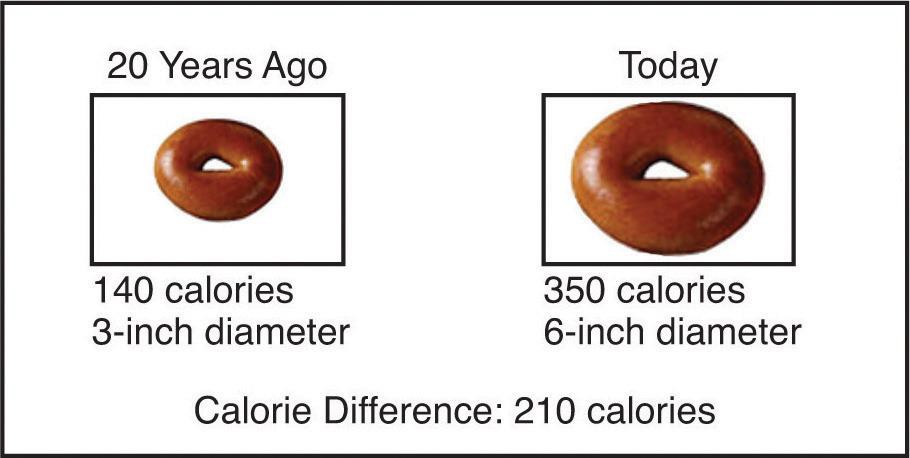Chapter 2: Achieving a Healthy Diet
2.8 When Enough Is Enough
Estimating Portion Size
Have you ever heard the expression, “Your eyes were bigger than your stomach?” This means that you thought you wanted a lot more food than you could actually eat. Amounts of food can be deceiving to the eye, especially if you have nothing to compare them to. It is very easy to heap a pile of mashed potatoes on your plate, particularly if it is a big plate, and not realize that you have just helped yourself to three portions instead of one.
The food industry makes following the 2010 Dietary Guidelines a challenge. In many restaurants and eating establishments, portion sizes have increased, use of fats and sugars has increased, and consequently the typical meal contains more calories than it used to. In addition, our sedentary lives make it difficult to expend enough calories during normal daily activities. In fact, more than one-third of adults are not physically active at all.

Dietitians have come up with some good hints to help people tell how large a portion of food they really have. Some suggest using common items such as a deck of cards while others advocate using your hand as a measuring rule. See Table 2.81 “Determining Food Portions” for some examples.
Table 2.81 Determining Food Portions[1]
|
Food Product |
Amount |
Object Comparison |
Hand Comparison |
|
Pasta, rice |
½ c. |
Tennis ball |
Cupped hand |
|
Fresh vegetables |
1 c. |
Baseball |
|
|
Cooked vegetables |
½ c. |
|
Cupped hand |
|
Meat, poultry, fish |
3 oz. |
Deck of cards |
Palm of your hand |
|
Milk or other beverages |
1 c. |
|
Fist |
|
Salad dressing |
1 Tbsp. |
|
Thumb |
|
Oil |
1 tsp. |
|
Thumb tip |
MyPlate Planner
Estimating portions can be done using the MyPlate Planner. Recall that the MyPlate symbol is divided according to how much of each food group should be included with each meal. Note the MyPlate Planner Methods of Use:
- Fill half of your plate with vegetables such as carrots, broccoli, salad, and fruit.
- Fill one-quarter of your plate with lean meat, chicken, or fish (about 3 ounces)
- Fill one-quarter of your plate with a whole grain such as ⅓ cup rice
- Choose one serving of dairy
- Add margarine or oil for preparation or addition at the table
Eating Interval and Portion Size
If you wait many hours between meals, there is a good chance you will overeat. If overeating at meals is something you struggle with, try consuming small meals at frequent intervals throughout the day as opposed to two or three large meals. Eat until you are satisfied, not until you feel “stuffed.” Eating slowly and savoring your food allows you to both enjoy what you eat and have time to realize that you are full before you get overfull. Your stomach is about the size of your fist but it expands if you eat excessive amounts of food at one sitting. Eating smaller meals will diminish the size of your appetite over time so you will feel satisfied with smaller amounts of food.
- American Cancer Society. “Controlling Portion Sizes.” Last revised January 12, 2012. http://www.cancer.org/Healthy/EatHealthyGetActive/TakeControlofYourWeight/controlling-portion-sizes ↵
Dietitians are nutrition professionals who integrate their knowledge of nutritional science into helping people achieve a healthy diet and develop good dietary habits. 1.1.
US federal government multimedia tool that aims to help Americans choose healthier foods from the five food groups (grains, vegetables, fruits, dairy, and proteins). Myplate.gov

